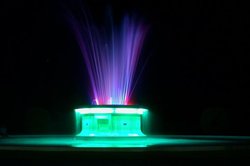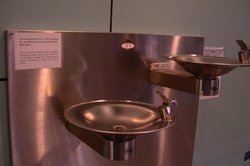Fountain
|
|
- Fountain is also the name of an artwork by Marcel Duchamp
- Fountain can also refer to a computer graphics technique to form a gradient of color, saturation, or brightness.
- A fountain (http://www.pyrouniverse.com/consumer/howtheywork.htm) is also the name of a firework which emits showers of sparks.
PeterhofSampsonFountain.jpg

Brooklyn-museum-splash-fountains1302p-nobather.jpg
Internationalfountain.jpg
A fountain is an arrangement where water is forced into the air under pressure, creating a jet; or is allowed to flow over a surface, possibly stone or metal. The pressure may be gravitational, or may be produced by a motor-driven pump.
A famous fountain rises from the surface of Lake Geneva. However, many fountains are located in small, artificial ornamental ponds, basins and formal garden pools, and often they are surrounded by statuary.
| Contents |
Animated fountains
Animated fountains often use laminar jets that provide water that moves like ping pong balls in animation, so that it breaks up, as the height varies, and the behaviour of each jet operates independently with up to 5Hz modulation frequency 1/5sec, so that the water packets collide with themselves. For example, the such fountains can spit up one ball of water which then explodes, showering people with a fine mist.
A musical fountain is a type of fountain that uses laser and harmonics principles to create three-dimensional images that look like holograms.
Other Meanings
In Islam a fountain is the name of the place in the Mosque where worshippers can wash before Prayer.
A water fountain is designed to provide drinking water and has a basin arrangement with either continuously running water or a tap. Modern indoor drinking fountains may incorporate filters to remove impurities from the water and chillers to reduce its temperature.
A splash fountain or bathing fountain is a fountain intended for people to cool off in. Although many fountains were not designed as bathing fountains, children of all ages often use them for that purpose. Some fountains are fenced in, or have raised edges as a barricade to keep people out. In other situations, fountains are designed to allow easy access, and feature nonslip surfaces, so that people can safely use them to cool off in on hot summer days.
More recently, splash fountains have begun to appear. These have zero standing water, to eliminate possible drowning hazards, so that no lifeguards or supervision is required. These splash pads are often located in public pools, public parks, or public playgrounds (known as spraygrounds).
A recent example of a public splash fountain, intended for waterplay, is the one located in Toronto's Dundas Square. It consists of 600 ground nozzles arranged in groups of 30 (3 rows of 10 nozzles). Each group of 30 nozzles is located beneath a stainless steel grille. Twenty such grilles are arranged in two rows of 10, right in the middle of the main walkway through Dundas Square. Both the architects and the designers have confirmed that these were intended for waterplay, and the facility operators have confirmed that the water is treated to pool water quality standards, and that the water quality is tested, by the health department, at least once a day. The entire surface of Dundas Square is made of special nonslip square granite slabs that match the size of the metal grilles. The special texture on the slabs ensures that they are not slippery when wet. Changerooms are located in level P1 of the public parking.
There is a mythological Fountain of Youth from which one can drink to gain immortality, or to regain their youth that plays a role in many fairy tales, stories, and oddysseys. On a less mythical note, splashing around in a fountain is a great way to feel youthful, thus the waterplay fountain is often said to be a fountain of youth.
The need for good water quality, regardless of intended use
Regardless of the fact that some fountains are designed and built not as bathing fountains, but are rather used simply as architectural decor, people will often drink from, bathe or wash their hands in any fountain. Therefore, minimum water quality standards are necessary, regardless of intended use.
In theory, a free-standing water feature shouldn't have a bather load, and subsequently, many builders would not choose to install filters or sanitation devices. In reality, however, people will interact with ornamental water fountains in the most surprising ways. In Disneyland, for example, people have been reported to change their babies' diapers and then wash their hands in the water fountain (thus adding unexpected bacteria and organics into the water). (Pool and Spa News Online) (http://www.poolspanews.com/2004/081/081hydraulics.html)
Legal liability of fountain owners and operators: Fence-it-in or treat the water
At the Minnesota Zoo, an outbreak occurred at an ornamental fountain because it did not have proper filtration and water treatment. Children played in fountains and swallowed water, and spurted the water out of their mouths to mimic the way nozzles in the fountain spurted the water. It was therefore necessary to put a fence around the fountain to keep people away.
Fountain operators and owners are legally liable for failure to either fence-in fountains, or to properly filter, chlorinate or otherwise treat the water, if the fountains are not fenced in. If the water is unsafe, fences must be designed to keep people far enough away, so that they cannot touch the water, otherwise children get water on their hands, and put their fingers into their mouths, and end up getting sick, thus subjecting owners and operators to legal liability.
Fountains for celebration
University of Albany has a "Fountain Day" every year which is a day in which the univeristy can come together to celebrate the coming of spring, and the near-end of the semester. This brings huge crowds celebrating together in the fountains, and creates something close in spirit to an urban beach.
Fountain day is a school sponsored event, initiated by the Human Awareness Program (HAP), in 1979, so students and faculty could break down the barriers that separate them. In 2004 Fountain Day was a media nightmare with drunk students and multiple injuries. As a response the University moved the event to a weekend, incresed security, and limited admittance to the fountain area itself to only UAlbany students. However, the fountain is central to the University community, and Fountain Day celebrates that centrality.
Famous fountains
- The Jet d'Eau in Lake Geneva
- The Trafalgar Square fountains in London.
- The garden fountains of the Palace of Versailles near Paris.
- The staircase and Atlas fountains at Peterhoff, the summer palace of Peter the Great
- The "Fountains of Bellagio" (http://bellagio.com/pages/attrac_highfountain_noflash.asp) at the Bellagio casino in Las Vegas
- Fontana di Trevi in Rome.
- Fountains in front of Brooklyn Museum (frequent frolicking, no standing water; less chance of drowning)
- Splash Fountains at Christian Science Plaza, Boston, MA (http://www.bostoncentral.com/activities/splash_fountain/p606.php)
- Dundas Square fountains designed by artist Dan Euser as both an architectural landmark as well as for frolicking (waterplay)
- Centennial Olympic Park (computer animated frolicking fountain with 251 ground nozzles that shoot 12 to 35 feet in the air)
- Urban Oases (http://www.yip.org/oases/)
- Vancouver's Harbour Green urban park with pavement waterworks fountains that kids can frolic in (http://www.igougo.com/planning/journalEntryActivity.asp?JournalID=36423&EntryID=39869&n=Canada+Place)
- Eaton's center fountain: 44 outer nozzles (each 3/8in dia. equiv. to clearstream product) fill a giant bowl that sprays 20 nozzles up, then bowl empties and one central nozzle shoots up approx. 10 meters, 3 times in succession, then process repeats.
- Fountain of Wealth (largest fountain in the world since 1998) In Singapore (http://www.sunteccity.com.sg/fountain/index.htm)
- The world's tallest fountain, located in the town of Fountain Hills, Arizona.
- Tyler Davidson Fountain at Fountain Square in downtown Cincinnati, Ohio.
- The waterfall cascade (http://www.nycjpg.com/2003/pages/0905.html) at Paley Park (http://www.pps.org/gps/one?public_place_id=69), New York City.
- The El Alamein Fountain (http://www.chhs.nsw.edu.au/chhs4b5.htm) in Fitzroy Gardens, Kings Cross, Sydney, Australia. Tubes and nozzles radiating from a hollow sphere (http://www.agit8.org/pixblog/?showimage=114).
- The fountain at Point State Park in Pittsburgh, Pennsylvania.
External links
- Fountains (http://www.gardening-uk.com/waterlands/fountains/index.html) – by Bryan R. Hirst. A Dissertation submitted to the Faculty of the School of Architecture, Kingston University
- Oregon Museum of Science and History WaterWorks (http://www.omsi.edu/visit/physics/ww/) page where you can investigate and build your own fountain and also view a gallery.
- Public fountains (http://www.adelaidecitycouncil.com/discover/visitor/landmarks_fountains.htm) in Adelaide, Australia.
- Paris fountains (http://www.pariswater.com/fontaines/).
- Kansas City, "City of Fountains" (http://www.kcfountains.org/).
- Fountains (http://www.peterhof.org/fount/) of Peterhof, Saint Petersburg, Russia.


